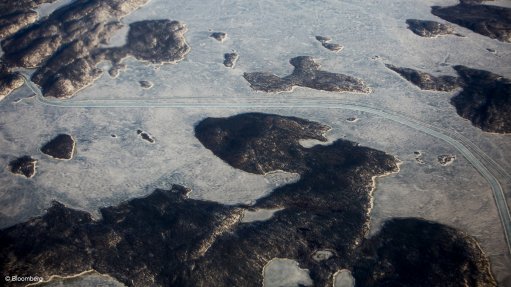
An ice road connecting Yellowknife and the Diavik diamond mine, in the Slave region of the Northwest Territories.
The Canadian federal government has announced an investment of C$5.1-million in two projects to support resource development in the mineral-rich Slave Geological Province (SGP) – an area in the eastern Northwest Territories and western Nunavut.
The two projects entail planning for the development of an all-season access corridor and an exploration development initiative.
A lack of infrastructure is consistently cited as a major impediment to exploration and development of the region, which already hosts three diamond mines – Ekati, Diavik and Gahcho Kue.
"Knowing where mineral deposits exist and being able to access them is the first step in attracting investment and growing the resource development sector. We know that similar projects in NWT in the past have led to significant economic development activity,” says Innovation, Science and Economic Development Minister Navdeep Bains, who is also responsible for the Canadian Northern Economic Development Agency (CanNor).
Canada is investing C$2.7-million and the government of Northwest Territories (GNWT) C$678 000 to fund studies for the development of an all-season access corridor into the SGP.
Existing mines are reached through a winter road and the immediate priority is to replace the southernmost section of the current winter road with an all-season gravel road. An all-season road could significantly improve the economics of many operating and potential resource projects by facilitating year-round access, as well as increasing the operating season of the winter road by at least 30 days.
The scope of the project includes updating economic and mineral potential studies, initiating consultation with Indigenous groups, undertaking wildlife and vegetation studies along the proposed alignment and identifying gravel sources for future construction.
As a result of the project, the GNWT will have further advanced planning and engineering work on the southernmost 179 km section of the proposed road with the goal of beginning construction within five years.
In the exploration initiative, CanNor is investing C$2.4-million, the GNWT is investing C$280 000, and industry partners are investing C$749 000 in a high-resolution airborne geophysical survey aimed at furthering resource development in the SGP.
The programme will target underexplored areas for their economic potential, at a scale that can potentially indicate the presence of previously undiscovered mineral deposits. As a result of the project, mineral explorations will have access to publicly-available mapping products which will lead to renewed multi-commodity mineral exploration in the territory—ultimately contributing to economic growth.
CanNor pointed out that previous similar work led to the staking of numerous mining claims and exploration drilling programmes by both major mining and junior mineral exploration companies in the SGP demonstrating that the area remains viable for diamond-bearing kimberlite discoveries.
The SGP, which covers about 190 000 km2, has significant potential for gold, base metals and diamond production. A 2016 study of relative costs has determined that costs for mining projects are 40% to 170% higher in the Northwest Territories, than in southern regions of Canada.